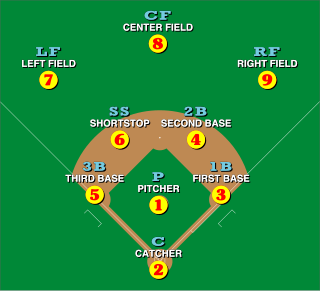
In the sport of baseball, each of the nine players on a team is assigned a particular fielding position when it is their turn to play defense. Each position conventionally has an associated number, for use in scorekeeping by the official scorer: 1 (pitcher), 2 (catcher), 3, 4, 5, 6 (shortstop), 7, 8, and 9. Collectively, these positions are usually grouped into three groups: the outfield, the infield, and the battery. Traditionally, players within each group will often be more able to exchange positions easily ; however, the pitcher and catcher are highly specialized positions and rarely will play at other positions.

Softball is a game similar to baseball, and it is played with a larger ball on a smaller field and with only underhand pitches permitted. Softball is played competitively at club levels, the college level, and the professional level. The game was first created in 1887 in Chicago by George Hancock.
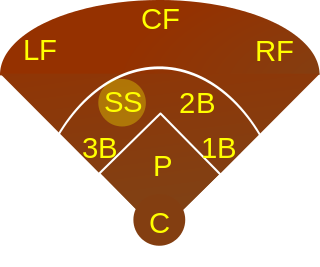
Shortstop, abbreviated SS, is the baseball or softball fielding position between second and third base, which is considered to be among the most demanding defensive positions. Historically, the position was assigned to defensive specialists who were typically poor at batting and were often placed at the bottom of the batting order. Today, shortstops are often able to hit well and many are placed at the top of the lineup. In the numbering system used by scorers to record defensive plays, the shortstop is assigned the number 6.
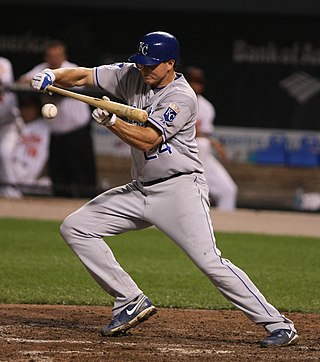
A bunt is a batting technique in baseball or fastpitch softball. Official Baseball Rules define a bunt as follows: "A BUNT is a batted ball not swung at, but intentionally met with the bat and tapped slowly within the infield." To bunt, the batter loosely holds the bat in front of home plate and intentionally taps the ball into play. A properly executed bunt will create weak contact with the ball and/or strategically direct it, forcing the infielders to make a difficult defensive play to record an out.
In baseball, fielder's choice refers to a variety of plays involving an offensive player reaching a base due to the defense's attempt to put out another baserunner, or the defensive team's indifference to his advance. Fielder's choice is not called by the umpires on the field of play; rather, it is recorded by the official scorer to account for the offensive player's advance without crediting him with an offensive statistic such as a hit or stolen base.
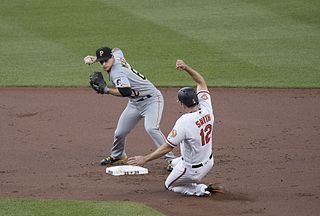
In baseball and softball, a double play is the act of making two outs during the same continuous play. Double plays can occur any time there is at least one baserunner and fewer than two outs.
In baseball, a triple play is the act of making three outs during the same play. There have only been 735 triple plays in Major League Baseball (MLB) since 1876, an average of just over five per season.
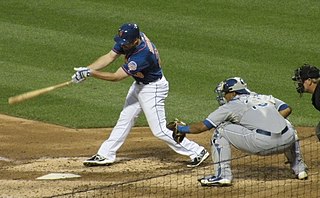
Catcher is a position in baseball and softball. When a batter takes their turn to hit, the catcher crouches behind home plate, in front of the (home) umpire, and receives the ball from the pitcher. In addition to this primary duty, the catcher is also called upon to master many other skills in order to field the position well. The role of the catcher is similar to that of the wicket-keeper in cricket.

A first baseman, abbreviated 1B, is the player on a baseball or softball team who fields the area nearest first base, the first of four bases a baserunner must touch in succession to score a run. The first baseman is responsible for the majority of plays made at that base. In the numbering system used to record defensive plays, the first baseman is assigned the number 3.
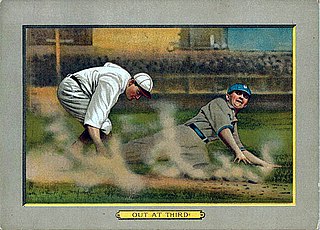
In baseball, an out occurs when the umpire rules a batter or baserunner out. When a batter or runner is out, they lose their ability to score a run and must return to the dugout until their next turn at bat. When three outs are recorded in a half-inning, the batting team's turn expires.

Throughout the history of baseball, the rules have frequently changed as the game continues to evolve. A few common rules most professional leagues have in common is that four balls is a base on balls, three strikes is a strikeout, and three outs end a half-inning.

In baseball and softball, while there are nine named fielding positions, players, with the exception of the pitcher and catcher, may move around freely. The positioning for the other seven positions is very flexible, although they all have regular depths—distances from home plate, and sometimes lateral positioning. A shift means that a player is playing in a noticeably different location than the norm for his positioning. A fielder who is playing shallow or in is playing closer to home plate, while a player playing deep is playing farther from home plate than normal.
A hit and run is a high risk, high reward offensive strategy used in baseball. It uses a stolen base attempt to try to place the defending infielders out of position for an attempted base hit.

Baseball scorekeeping is the practice of recording the details of a baseball game as it unfolds. Professional baseball leagues hire official scorers to keep an official record of each game, but many fans keep score as well for their own enjoyment. Scorekeeping is usually done on a printed scorecard and, while official scorers must adhere precisely to one of the few different scorekeeping notations, most fans exercise some amount of creativity and adopt their own symbols and styles.
This is an alphabetical list of selected unofficial and specialized terms, phrases, and other jargon used in baseball, along with their definitions, including illustrative examples for many entries.
The wheel play is a defensive strategy in baseball designed to defend against a sacrifice bunt. The play's name derives from the wheel-like rotation of the infielders.











